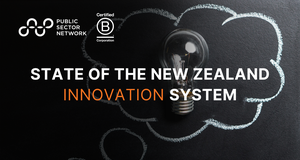Accelerating the development of enterprise architecture capability across the public sector

Learn from Rosemary McGrath, Chief Architect & Chair, Government Enterprise Architecture Group from Statistics New Zealand on revitalising the NZ Government Enterprise Architecture with a focus on Data, Information, and Analytics
At the recent Enterprise Architecture virtual event, we heard from Rosemary as she dived into how does the design for a ‘high performing’ data system really looks like. In her presentation she explored:
- Key data assets, access, and what levers (legislation. policy, governance) enable the best access and use for EA
- How to work across the functional leadership roles, Government Chief Digital Officer, Government Chief Data Steward, Government Chief Information and Security Officer
- How to take a co-design approach to streamline services
A refresh based on data

Governments of all sizes and across all jurisdictions exist to provide services and make life better for their citizens. These days, all governments use various forms of technology, and to ensure that it all runs smoothly, enterprise architects standardise and organise the IT infrastructure to make sure that it aligns with business goals. At Statistics New Zealand (Stats NZ), Rosemary McGrath , the Chief Architect and Chair of the Government Enterprise Architecture Group, says that they are currently in the process of a “refresh to broadening of the enterprise architecture role.” In particular, it is about ensuring that data is at the forefront because “data is the lifeblood of digital.”
Unlike in other organisations, the CEO or chief statistician at Stats NZ is also the “government chief data steward (GCDS),” and the refresh came about because the GCDS wanted to know “what are the key data assets, and what policy or governance levers enable access and use.” New Zealand’s government enterprise architecture provides a simple structure for information and tools that support “a purposeful change and the refresh, in particular, is focussed on the data, information and analysis domains.” The refresh also came about because governments often have “good intentions and good ideas, but then priorities within the organisation change, or people leave, and quite quickly the information and guidance degrade as the environment around us changes.”
"When we started looking at our enterprise architecture and our data, we thought rather than just do a review of the content and see if there’s anything that needs updating, we’d instead take a look at what’s happened in the world since it was created and see what we’re losing in terms of relevance."
As part of the review, they found that the framework was sound but legislation and expectations have changed “so we need to move beyond data that just supports government service delivery.” The frameworks and the data now need to support “the state of our nation and the wellbeing of our people.” That means including things like “geospatial or observational data and preparing for things like machine learning and AI, all of which require significantly different data management styles.” The other thing that was missing – which is very topical and relevant – was around “Maori data governance and indigenous data sovereignty. We need to grow our understanding of these perspectives and we need to design and architect for them.” Part of this is also related to understanding the political, ethical, and moral environments that enterprise architecture sits in, and how data is used. In governments and wherever there is technology, “architects are everywhere and need to understand their impact.”
Lessons and areas of focus
The refresh brought out a number of issues that were probably already known to Stats NZ and to other government agencies but were suddenly thrust into the spotlight. For instance, even for government enterprise architects, “government websites are generally not the first port of call for content.” Most people rely on their own networks and on Google. In fact, the pandemic has shown that in many industries and communities, personal networks and “how people work and come together” are most important to them. In terms of data, the focus needs to be on “making sure we support how that data is going to be used.” Different processes actually require different models of use. “As architects, we need to focus on use cases and how decisions are made and how policies are implemented to help all people live better lives, and to really support the way they want to live in New Zealand.” What this really means is that the outcomes of architecture need to be “to be related to the people who use the services and who are impacted by the policies, and not just related to the outcomes of the business.”
In the digital age, this means having “collaborative units that make the capability, capacity, knowledge, and tools available more widely.” Currently, governments and the units within them are very siloed, sometimes to the extent that even their own networks “don’t know where their capabilities reside.” Enterprise architects tend to have their own language, but “we have to learn to talk other languages so that people understand what it is we’re trying to enable.” No matter how good something looks or what it can do, without the associated communication many of the features will be lost, and that often happened in the past. Moreover, architecture tends to “focus on a point in time, but the world changes around us. We need to embed the external environmental factors.” In a government agency, this is particularly important because there is a constant movement of people, and priorities may also change, “but you want to feel like there’s value and benefit in keeping things going.” To that end, one of the key areas of focus is “to do what we can with what we have now.”
To ensure that architects “don’t dive down rabbit holes,” which often happens, the refresh included the creation of a “scope narrative, which is a model that frames and summaries the co-design discussion by focussing on the scope of what architects would like to see.” In other words, it is a target “so that we know what we’re really here to do.” In this case, it is a design of three concentric circles with ‘collaboration’ in the centre, ‘principles’ in the second tier, and ‘data system infrastructure’ on the outer circle. “There was such a lot of discussion about why ‘principles’ aren’t in the middle.” The consensus was that they can’t be because “currently there are over 100 and we’re reviewing them. When there’s so many, people use none of them,” so something else had to be seen as being more central. What was chosen was “collaboration, which includes advocacy and the general ability to make transparent the skills, capacity, and capabilities that are available among our community. Without that at the centre, people will go back to Google.”
Since it was created, the scope has been reviewed and tested by external research consultants, and it was also updated to ensure “we’re not missing any key elements.” The only criticism was that alongside the scope is a “need to build data literacy.” The ultimate goal of the scope and the refresh is to “develop a rocking data system.” This means “always remembering that the outcomes are just as important as the deliverables – making sure that what we enable is actually what’s needed.”
Enterprise architects are often seen as being too optimistic or living in a utopian world because what they design can be “way too far from our current state, and that in their target state the world is perfect, but that’s not the real world.” Part of the reason why nothing is ever perfect, especially in the world of enterprise architecture, is because “we have a lot of heritage that’s visible in our systems.” Often those things are difficult to change or untangle, so the role of the architect is to “make the best of the mess.” Even all the capability and money in the world will unlikely fix some of the ingrained issues that “will constantly be recreated anyway.” The key is to explore different paradigms and to focus on what can be fixed or re-structured “without having to radically change everything.” This is partly because it is very clear that “one size does not fit all.” Governments come in different sizes and so do their communities. “We’re really trying to look at what is real guidance and practice, not just a perfect or ideal solution, to support the world we live in.”




















